|
I very seldom get to shoot my guns. I have a
few, and like every one of them, but I usually spend all of my
shooting time shooting someone else’s guns. There are always a
few test guns in here that need to be fired for function and
accuracy, so the majority of my shooting time is spent with
those. Unlike some of the paper magazines, and a few of the
online magazines as well, we shoot every gun that comes in here
for review, and shoot them a lot. To do it right, it takes a lot
of time and ammunition, but to me this job is still a lot of
fun, so I don’t mind doing it at all. The problem is, it
leaves very little time to enjoy my own guns, as usually I am
involved with something brand new and interesting. However, I am
going to use this opportunity to have a look at a dandy little
carbine that has been around here for a few years; the Marlin
Camp 9. Actually the Model 9 Camp Carbine, it has come to be
called the Camp 9 among most users of the rifle. Never as
popular as it should have been when it was on the market, the
Camp 9, along with its big brother the Camp 45, has developed
somewhat of a cult following since its production was
discontinued in 1999. The Camp 9 was built for fifteen years,
and was a handy little semi-auto that came with a twelve shot or
a twenty shot magazine, but could use any magazine that fits a
Smith & Wesson 59 series pistol, such as the Models 59 and
5906, to name just a couple. One thing that surely led to its
demise was the Clinton-inspired ban on normal-capacity
magazines, regulating every semi-auto to ten shots or fewer.
Another thing that hurt the carbine’s popularity was that it
did not look like a “tactical” rifle. Some gun owners think
that a rifle has to be plastic and black for it to be effective
as a fighting tool. That is a marketing conception. Some
“shooters” are not satisfied unless a rifle is flat black
with attachment points to hang every possible contraption onto
the rifle. The Camp 9, to some, looks more like a sporting or
hunting rifle. It even looks a lot like some of Marlin’s dandy
little .22 rimfire rifles. Also, the rifle was marketed as an
all-around outdoorsman’s gun, much like the Ruger
Ranch Rifle. Many folks who are looking for a carbine for home
defense overlook the Camp 9, but that is a mistake. While
the Camp 9 can serve well as an intermediate range predator and
varmint gun, it can also do service as a handy little home
defense carbine that has very little recoil, yet ample power to
get the job done. While the 9x19mm Luger cartridge is certainly
not a magnum, many rely upon it in a pistol, but overlook it as
a choice for social work when chambered in a carbine. However,
from a carbine-length barrel, the 9mm offers better performance
and is easy to shoot accurately and quickly. It is an ideal
choice for those who do not like the recoil and noise of more
powerful rifle cartridges. While the 9mm will never replace a
7.62x51mm (.308) as a main battle rifle, most of us do not need
a main battle rifle. We will not be attacking a fortified
machine gun nest on the side of a mountain, but might very well
have to defend our home from an intruder, or several of them.
This is where a lightweight carbine that can lay down fire
quickly and accurately can be very useful, and the Camp 9 serves
this role well. It is a carbine with which family members who
are not really into shooting can be taught to use rather
quickly, and again, even stoked with Plus-P high performance
ammunition, the Camp 9 has very little recoil.
Weighing in at about six and one-half pounds
with an overall length of 35 ½ inches, the Camp 9 is
quick-handling, yet still has the heft to make it feel like a
real gun. It is a solid little carbine. Operating from a
blow-back semi-auto action, the bolt is a solid steel,
nicely-machined piece. It has a single recoil spring on a guide
rod, and is very reliable. One thing that I do recommend is to
replace the recoil spring with a twenty-one pound spring from
Wolff. By changing out that spring, one can use high performance
Plus-P ammo, without stressing the gun. It also eliminates the
action “spitting” burned powder upon a left-handed shooter.
The rifle works just fine as delivered from the factory, but the
heavier spring is much better, and allows the use of more
powerful ammo. Even with the Wolff spring installed, the Camp 9
still cycles just fine with standard pressure ammo, but it
cycles much smoother than with the factory spring. The magazines
feed the cartridges very well, and the action locks open on an
empty magazine. As mentioned above, the carbine uses either
twelve or twenty shot mags, but even magazines with a capacity
as high as thirty have been available to fit the S&W pistol,
and they work well in the Camp 9. Still, I prefer the shorter
twelve and twenty-round versions. The safety on the Camp 9 is
very easy to use, rear for “on safe”, and push forward to
fire, just like on a Garand or a Mini-14. It is very natural to
operate, and works as well for left-handed shooters as it does
for right-handed shooters. I hate a push-button crossbolt
safety, and the safety on this Marlin was designed just as it
should be. Disassembly for cleaning is very simple and easy to
perform. The parts are robust, and very straightforward in
operation.
The Camp 9 has a very good set of open
sights, but for a rifle that might be used in low-light
conditions, whether for shooting a fox that is doing a night
raid on the hen house, or for more serious purposes, I like an
optical sight with night-time
capabilities. The perfect choice for a carbine such as this
is a reliable red dot, and I keep a Trijicon Red Dot mounted on
the top of mine. While it is on my mind, any scope base for a
Marlin lever action 336, 444, or 1895 will work perfectly on the
Model 9 and Model 45 Camp Carbines. The Trijicon is a rugged
little unit, and with its Weaver adaptor, weighs less then two
ounces. The dot is bright and easy to see, even in daylight, and
shooting with both eyes wide open, it is easy to see the target
and everything that is going on around the target. It does not
give the shooter tunnel vision like when looking through a
scope, and out to one hundred yards, it is perfectly suited to a
man-sized target.
From the Marlin’s sixteen and one-half inch
barrel, 9mm Luger ammo exhibits some pretty impressive
velocities, for a pistol cartridge. I chronographed a few types
of ammo, with the chronograph set at ten feet from the muzzle.
Velocities are listed in the chart below in feet-per-second
(fps). Bullet weights are listed in grains. HP is a jacketed
hollowpoint bullet. PB is Cor Bon
PowRBall, a specialty hollowpoint with a plastic ball in the
nose. DPX is a homogenous copper hollow nose bullet. HS is a
hollowpoint with a post insert to promote expansion. FMJ is a
full metal jacket bullet. Velocities were recorded with an air
temperature of sixty-one degrees Fahrenheit at an elevation of
around 550 feet above sea level. Accuracy is the average group
size for a three-shot group at fifty yards. Group sizes are
listed in inches. The GECO FMJ was not tested for accuracy. I
have precious little of it left, and do not waste it on paper.
| Ammunition |
Bullet Weight |
Velocity |
Accuracy |
| Cor-Bon DPX |
115 |
1330 |
1.75" |
| Cor-Bon PB |
100 |
1692 |
5.375" |
| Cor-Bon HP |
115 |
1532 |
0.875" |
| GECO FMJ |
124 |
1306 |
|
| Buffalo Bore HP |
115 |
1646 |
3.5" |
| Buffalo Bore HP |
124 |
1458 |
2.125" |
| Buffalo Bore HP |
147 |
1225 |
1.375" |
| Federal HS |
147 |
1155 |
0.75" |
As can be seen, accuracy varies from
not-so-good to excellent from my particular Camp 9 carbine.
Velocities recorded are well above what is exhibited from a
standard pistol barrel. Recoil was very mild, and the carbine
was easy to shoot. Mine has a trigger pull that measures almost
five pounds , but is pretty crisp, and much better than the
trigger on a typical AR-15, and is superb when compared to an
AK. My Camp 9 has always been one-hundred percent reliable with
every type of 9mm ammunition that I have ever fed it.
While the Camp 9 has been out of production
for ten years now, they can still be found for reasonable prices
on the used market. While there are other 9mm carbines on the
market today, the little Camp 9 is still one of my favorites. I
wish that Marlin would bring it back one more time, but it is
doubtful that they will do so. The truth is, if it had a black
folding stock and several feet of Picatinny rail to hang
flashlights and such, it would probably sell like beer at
Sturgis. The Camp 9 is not as “tactical” looking as many
carbines on the market, but it is still an accurate, reliable,
fun little gun to shoot that can serve well to protect the
homestead.
Jeff
Quinn
|
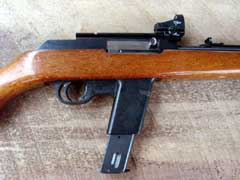
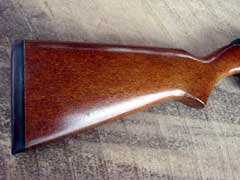
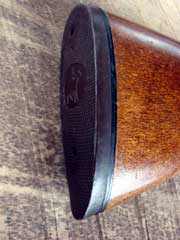
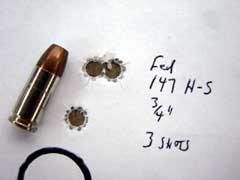
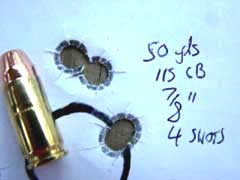
The Camp 9 is capable of fine accuracy.
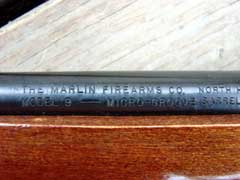
|
  
Got something to say about this article?
Want to agree (or disagree) with it? Click the following link to
go to the GUNBlast Feedback Page.
|
|
Click pictures for a larger version.
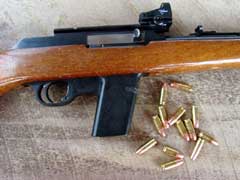
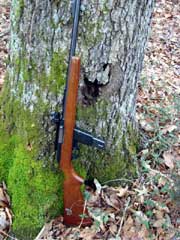
Marlin Model 9 "Camp Carbine".
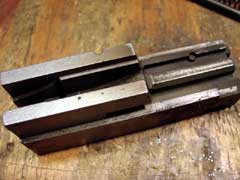
Internal parts are simple and robust.
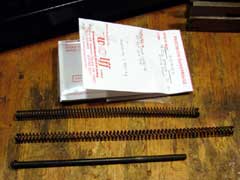
Stronger, 21-pound Wolff recoil spring is highly
recommended.
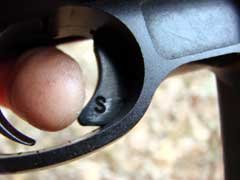
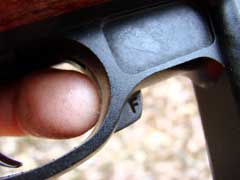
Safety is exactly where it should be, easy to use
with either hand.
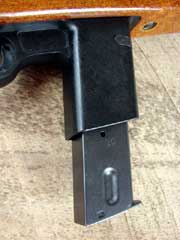
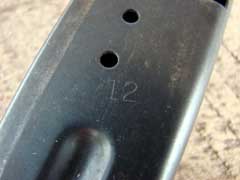
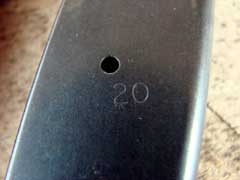
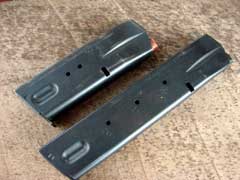
The Camp 9 can use any Smith & Wesson 59 Series
magazine.
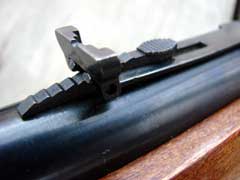
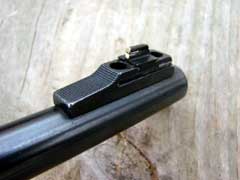
Open sights consist of semi-buckhorn rear (top) and
bead front (bottom).
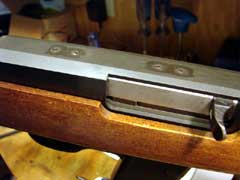
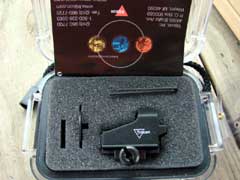
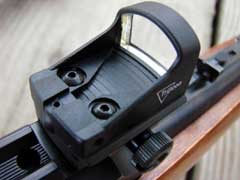
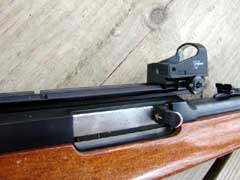
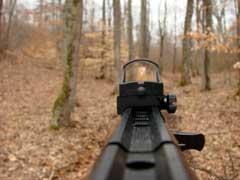
Trijicon's red dot sight is perfect on a handy gun
such as the Camp 9.
|
![]()